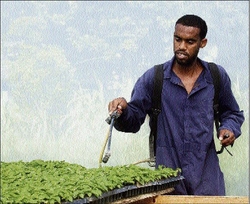Success for St Ann farmer
Published: Thursday | March 26, 2009

Pepper farmer Conroy Cole fumigates pepper seedlings on his farm in St Ann. - Contributed
As the Ministry of Agriculture intensifies its efforts to boost production and productivity within the agricultural sector, pepper has become an area of focus, locally and internationally.
St Ann farmer Conroy Cole welcomed the initiative and was extremely pleased that the ministry was setting up pepper nurseries across the island to give farmers an opportunity to provide quality planting stock for the trade.
Beefing up supplies
Cole is one of the 16 beneficiaries to establish pepper nurseries through the direct assistance of the ministry's Agricultural Support Services Project (ASSP), which aims at beefing up supplies.
Currently, his 175-acre farm is outfitted with an 80x30-foot nursery capable of producing up to 120,000 plants every six weeks, using 72, 90, 100 or 200-cell seed trays under greenhouse conditions.
However, he explained that he cultivates seedlings based on a per-order basis, as doing so ensures that all the plants are available at the required time. The method also means a backlog is prevented and, most importantly, a relationship is built between buyer and supplier.
Although the nursery is now operating about half its capacity, Cole said plans were afoot to mechanise the facility in a bid to reduce the manual labour and time required to sow the seeds.
The 32-year-old Cole, like many Jamaicans, wanted to be self-employed and agriculture was an easy choice considering he was already in possession of arable land, used at that time to rear cattle.
Following the downturn of the dairy industry in the 1990s, the animals were sold and pumpkin, tomatoes and hot pepper were put in the ground.
The yields for the tomatoes and pumpkins were great, but there was no market. A similar situation existed for the pepper but demand still outweighed supply.
Naturally, more acreage was planted to service the demand and now-lucrative sector, but that success was to be short-lived as, soon after, Hurricane Ivan foiled plans.
Injection of input by the USAID in the form of irrigation equipment was enough to encourage renewed spirits, and shortly thereafter, 13,000 Scotch bonnet seedlings per acre in high-density pepper was back in the ground.
Creative measures
His fate was similar to years gone by, as yet again his field sustained severe damages from another hurricane.
Not deterred by the many challenges, Cole decided on a creative way of cultivating to maximise profits.
The business-savvy young man explained that although he primarily engaged in large-scale pepper production, he had already constructed a small wooden nursery with an output of some 30,000 plants from which he would replenish the field.
Orders for seedlings came from far and wide and soon after he became the household name for seedlings in St Ann.
Little did he know that his trials and forward-thinking were prepa-ration for things to come.
Since January, when Cole constructed his pepper nurseries, approximately 80,000 plants have been churned out.








